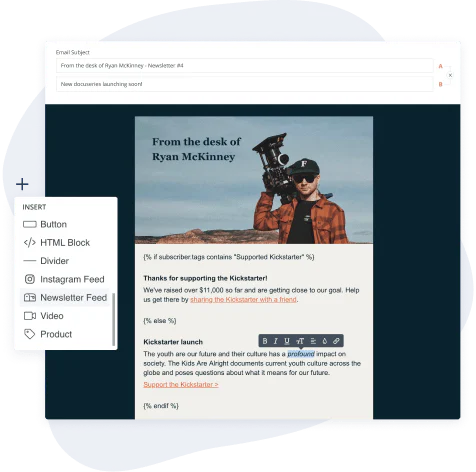In this Article
The idea of starting an email list and building a new marketing channel to connect with subscribers is exciting.
But getting email subscribers is only half the battle. Applying newsletter best practices to keep them engaged and on your list is a whole other task.
We want you to create and sustain a great newsletter audience. So we’ll walk you through our top email newsletter tips. Learn everything you need to create quality newsletters your subscribers will be delighted to read!
Best practices for quality newsletter signups
The success of your newsletter depends a lot on finding the right audience. This starts with quality signups.
1. Let people know about your newsletter
People can only subscribe to your newsletter if they know it exists.
So don’t be afraid to spread the word. Use platforms like your social media accounts, YouTube channel, website, or referral programs to grow your newsletter.
Providing sign-up incentives like an email newsletter course or downloadable lead magnets can attract more subscribers. If you do promise a lead magnet, deliver exactly what you offered. Otherwise, you’ll probably lose subscribers because they won’t be able to trust you.
Example: Michelle Watson of The Book Devotions
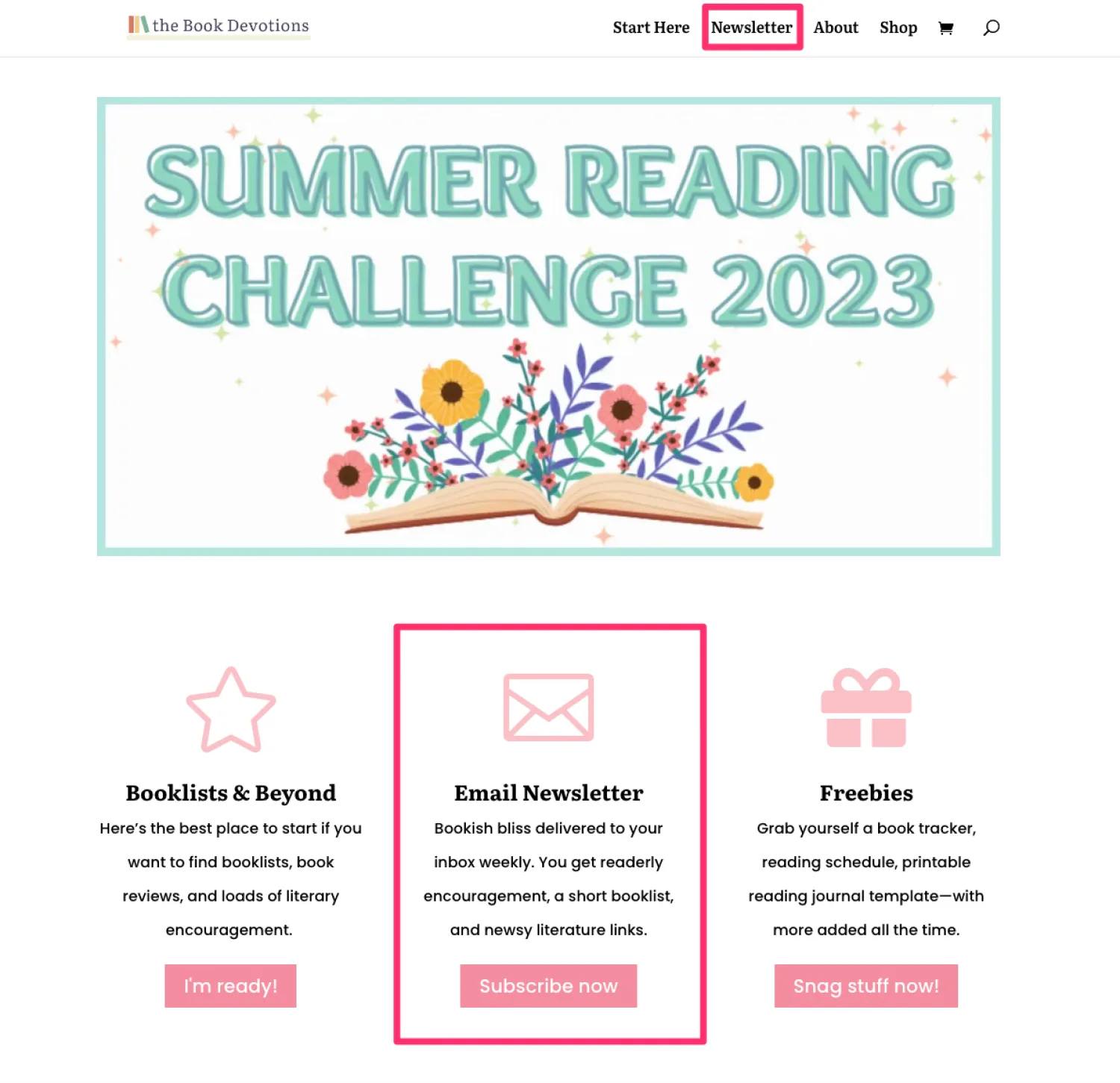
Promote your newsletter landing page by linking it to your website’s menu bar
Michelle, who runs The Book Devotions, advertises her newsletter by:
- Linking to its landing page on her website’s menu bar
- Adding two other sign-up calls to action on her homepage
- Linking to its landing page on her YouTube channel
Altogether there are three opportunities on her website homepage alone for visitors to subscribe on their first visit.
2. Set clear expectations and stick to them
The average American worker sends and receives around 126 emails per day. Inboxes are busier than ever, and consumer attention is sparse.
It’s easy to get lost in the mix. Unless you’re consistently sending your email newsletters, subscribers can quickly forget who you are and why they signed up to receive your newsletters in the first place.
A consistent email newsletter will help subscribers identify you and build a strong connection with your brand. On your newsletter landing page and signup forms, let readers know right off the bat what, when, and how often to expect your emails.
Example: Lizzie Davey at Copy Revival
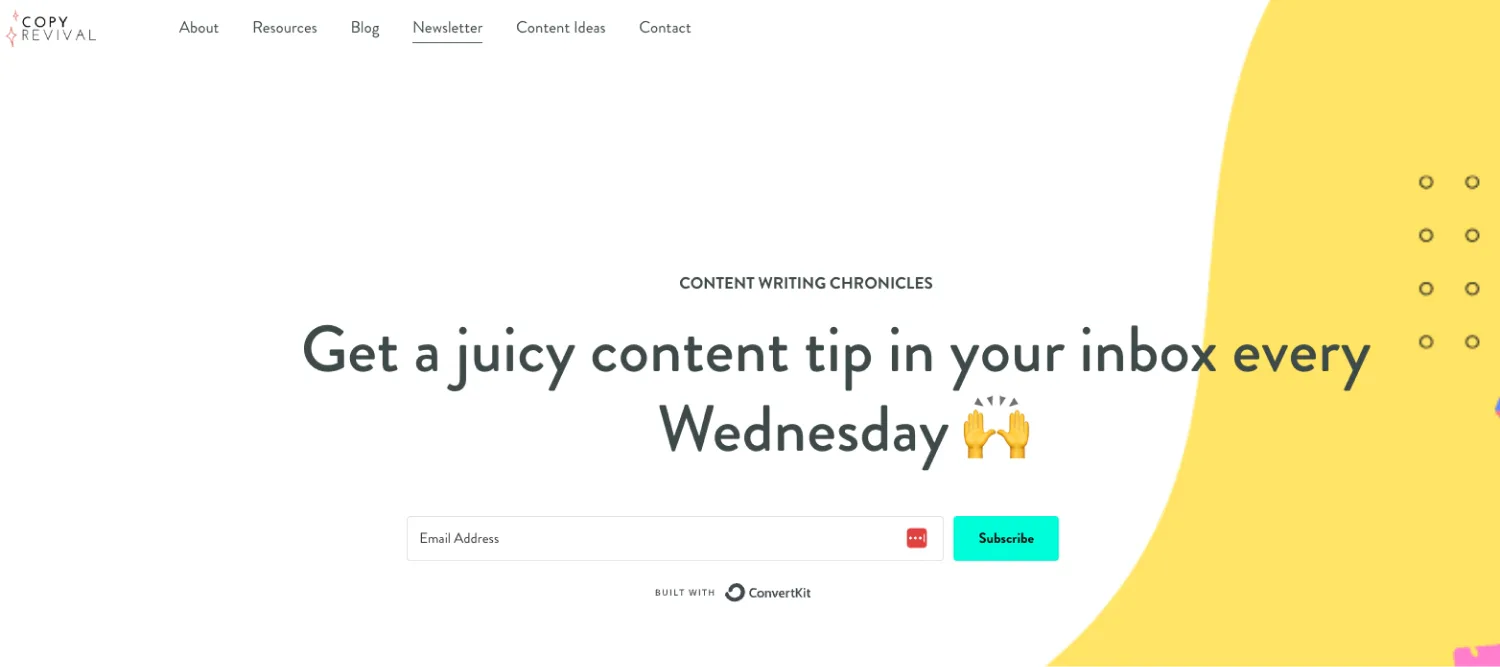
Lizzie tells subscribers when they can expect her emails
Freelance writer Lizzie Davey runs Copy Revival and sends a weekly email newsletter. She stays consistent and trustworthy by:
- Telling new subscribers how often they can expect her emails
- Sharing what kind of content subscribers can expect—“a juicy content tip”
- Following up with her promises—Lizzie never misses a Wednesday!
3. Stay out of your subscribers’ spam folder
No one wants their hard work to go unseen by subscribers. That’s what happens when your email ends up in the spam folder.
One way to stay out of the spam folder is by having good email deliverability. Having subscribers who engage well with your emails is one key factor that improves your email deliverability.
To build healthy engagement, weed out low-quality subscribers. A double opt-in can help with this right at the sign-up stage.
With double opt-in, when someone first signs up for your newsletter, they’ll be prompted to confirm their email address before they are added to your list of subscribers.
Subscribers who confirm their subscriptions opt-in twice (at sign-up and confirmation). This ensures they’re not bots and they signed up purposefully.
Having subscribers who actually want to receive your emails improves your open rates and, by extension, keeps you out of the spam folder.
Of course, deliverability is more complex than simply using double opt-in. You can read all about it in our article about email deliverability.
Example: Preethi of Local Passport Family
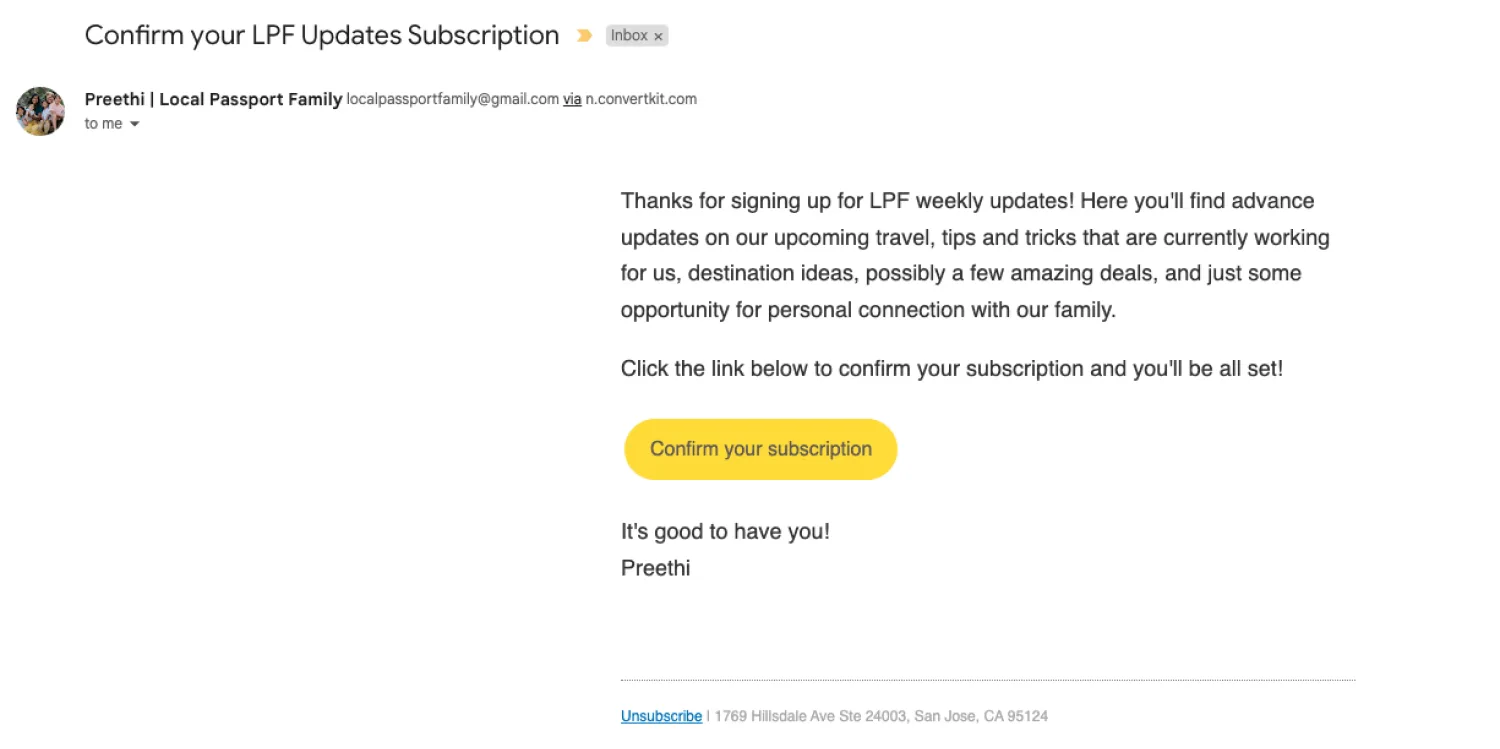
Confirm subscribers using double opt-in
Preethi of Local Passport Family ensures she collects only high-quality subscribers by using double opt-in to ensure subscribers confirm their subscription
Best practices for newsletter creation
Follow these email newsletter best practices as you write and design each newsletter.
4. Pay attention to your subject line and preview text
The subject line is often the first piece of your newsletter your audience will see. If it’s not compelling, they’ll quickly move on to the next email.
A click-worthy subject line:
- Contains essential information near the front, so it doesn’t get cut off on smaller devices
- Piques curiosity and compels your reader to open your newsletter
- Isn’t too long—subject lines 50 characters and shorter get 12% higher open rates
After your subject line, your preview text is valuable real estate you shouldn’t ignore!
The preview text is what your recipients see after the subject line. It gives a glimpse into your newsletter. Better still, you can customize your preview text to say whatever you’d like.
If you don’t customize the preview, it defaults to the first line of your email, which may be boring text like a greeting, for example.
Example: Rachel Pilcher of Mighty Freelancer
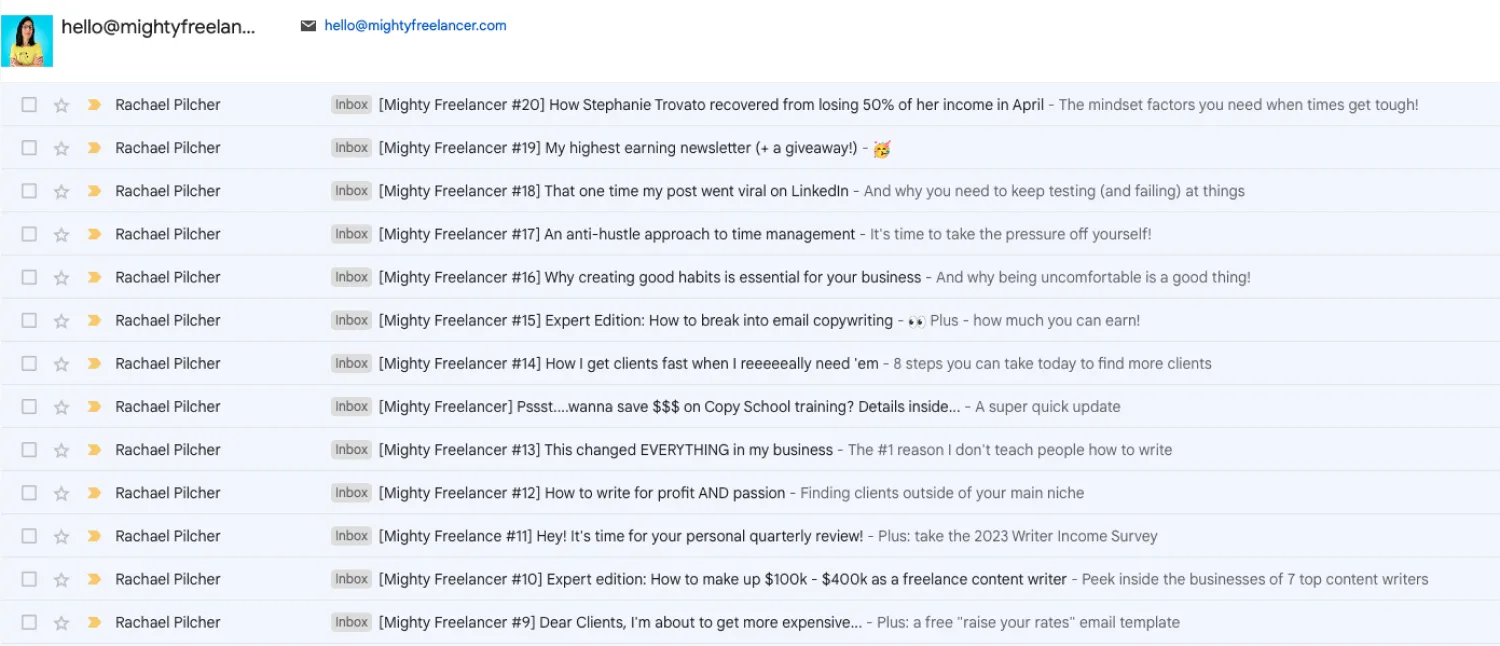
Freelance copywriter Rachel Pilcher writes exceptionally enticing subject lines and preview text. For example, she writes:
Subject line: That one time my post went viral on LinkedIn
Preview text: And why you need to keep testing (and failing) at things
I open every email from her because:
- Her subject lines are all about 50 characters or less
- She always customizes her preview text to whet readers’ appetites
- Her subject lines and preview text always complement each other well
5. Make sure your newsletter design matches your brand
Pictures, videos, and GIFs are fun ways to engage your audience. But when it comes to email newsletter best practices, less is more.
For one, skip embedded videos. Video files are usually large and can cause your email to bounce. Instead, add a link to a video screenshot with a play button so readers who click are redirected to the video.
Don’t skip adding alt-text.
Alt-text is handy, especially when your images don’t load, or your user can’t see them. It’s the text screen readers read aloud. Your alt-text should describe the content of your images so that visually impaired readers can benefit from them too.
Finally, your overall newsletter design should be cohesive, consistent, and in harmony with your brand. Ideally, readers who follow you on other channels like your blog or YouTube should easily recognize your newsletter design.
Example: Jules Acree
Blogger and YouTuber Jules Acree’s newsletter branding is airtight.
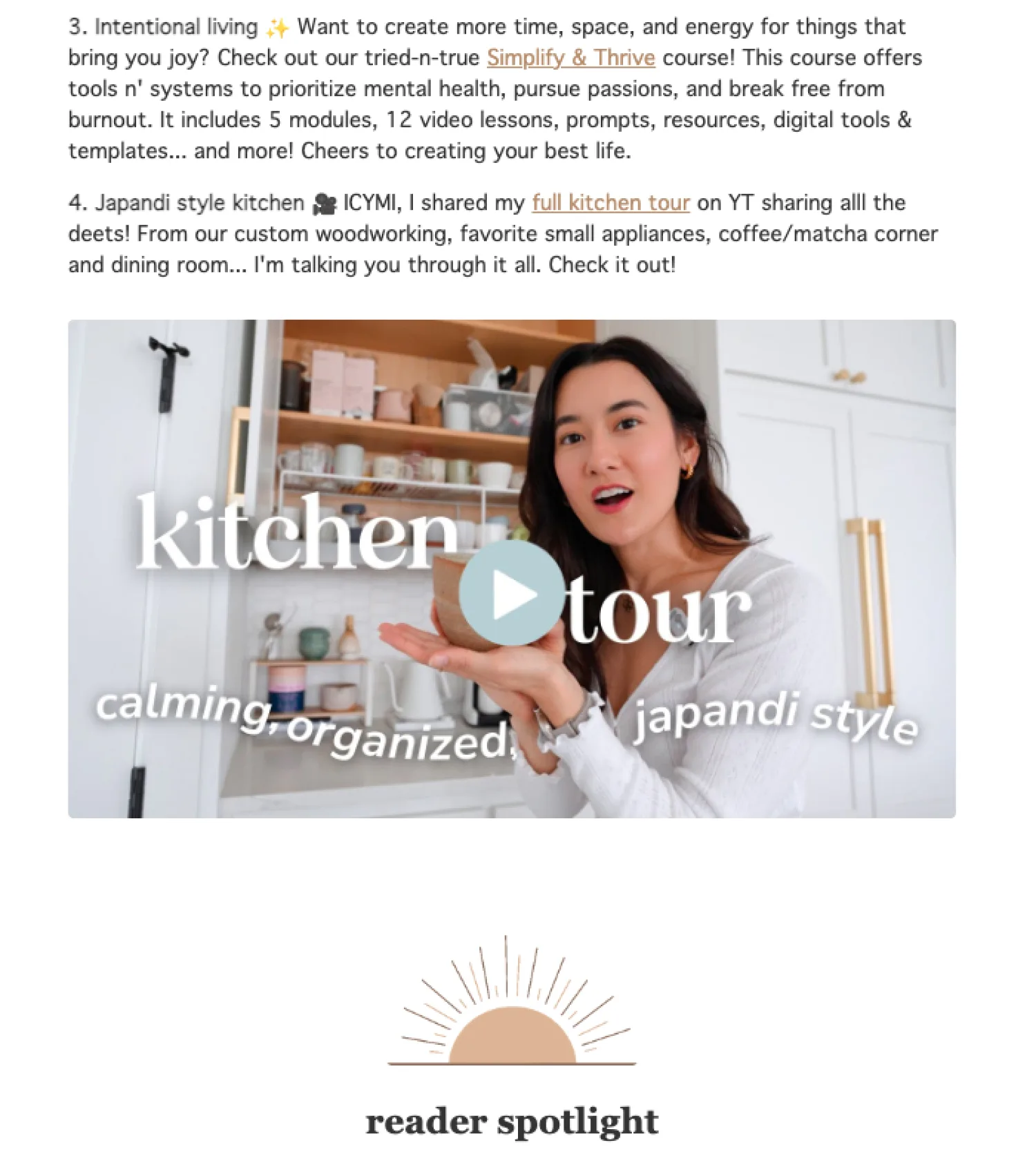
Jules Acree maintains consistent branding in her newsletter design
Jules uses:
- The same text font on her website and newsletter
- The same color palettes on her website and newsletter
- Links to her videos (attached to screenshots) instead of embedded videos in her newsletter
6. Make reading your newsletter easy
How we enjoy reading content online differs vastly from how we read offline (think books or research papers).
For online content, readers enjoy short paragraphs and digestible copy. It’s worth learning how to write a good email that appeals to readers.
You can achieve this in your newsletters by making sure you have:
- Bullet lists to organize list-type data
- Paragraphs that are 1-3 sentences long
- Bold/italicized text to emphasize important information
- Headers dividing up long content into suitable sections
- Contrast for your call-to-action (such as links that differ in color from your body text)
- Web-safe fonts so your readers can view your email exactly how you designed it
Lastly, take the time to do a quick spelling and grammar check. Grammarly is a freemium app to check your newsletters before hitting send.
Example: Niche Twins
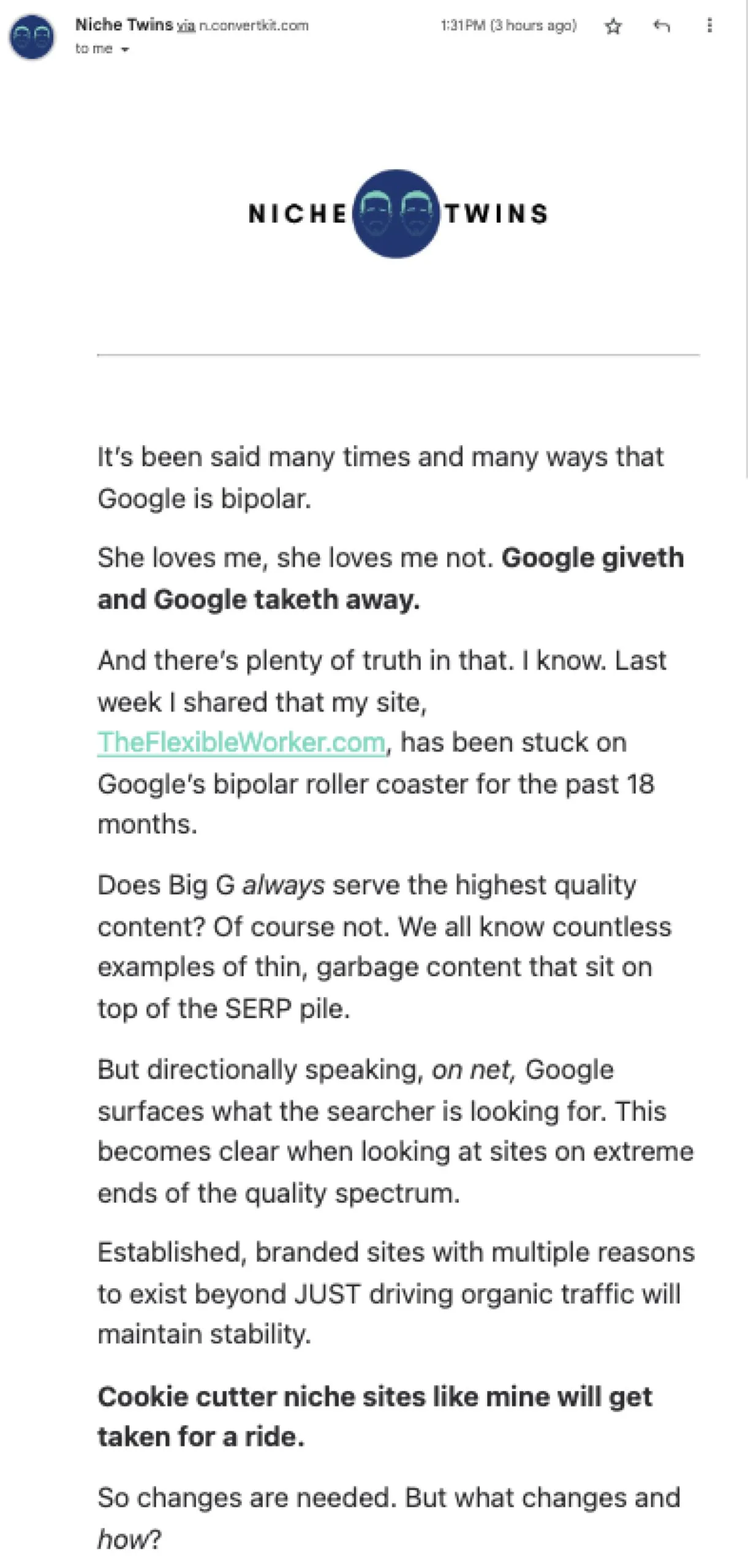
Make your emails readable by making the main points stand out
The NicheTwins newsletter does a great job of crafting readable emails. Notice that the email in the screenshot has:
- Short paragraphs—none over four lines long (even on mobile)
- Bolded sections and italicized words emphasizing the main points
- Links in contrasting colors for increased visibility
7. Optimize for different devices
46% of people read emails on their mobile devices.
To be sure your newsletter looks great no matter what device it’s read on, keep in mind:
- Make sure you have enough white space on smaller screens so your newsletter isn’t an overwhelming text block.
- Your images should be distinguishable on small and large screens. If your media looks funky when shrunk down, you may want to replace or remove it.
Example: Reading Middle Grade
Here’s what my weekly newsletter looks like on a desktop and a mobile device.
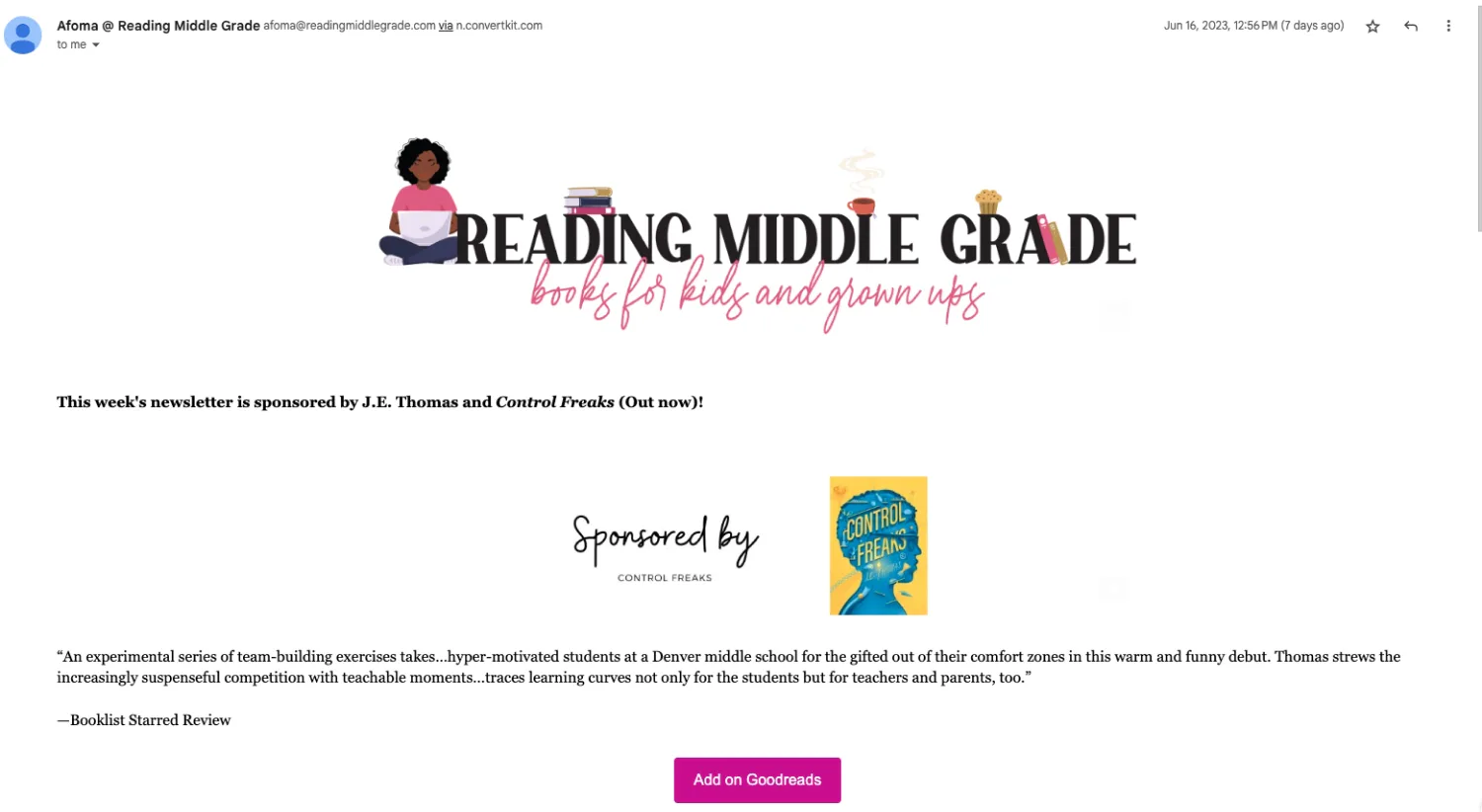
Desktop view
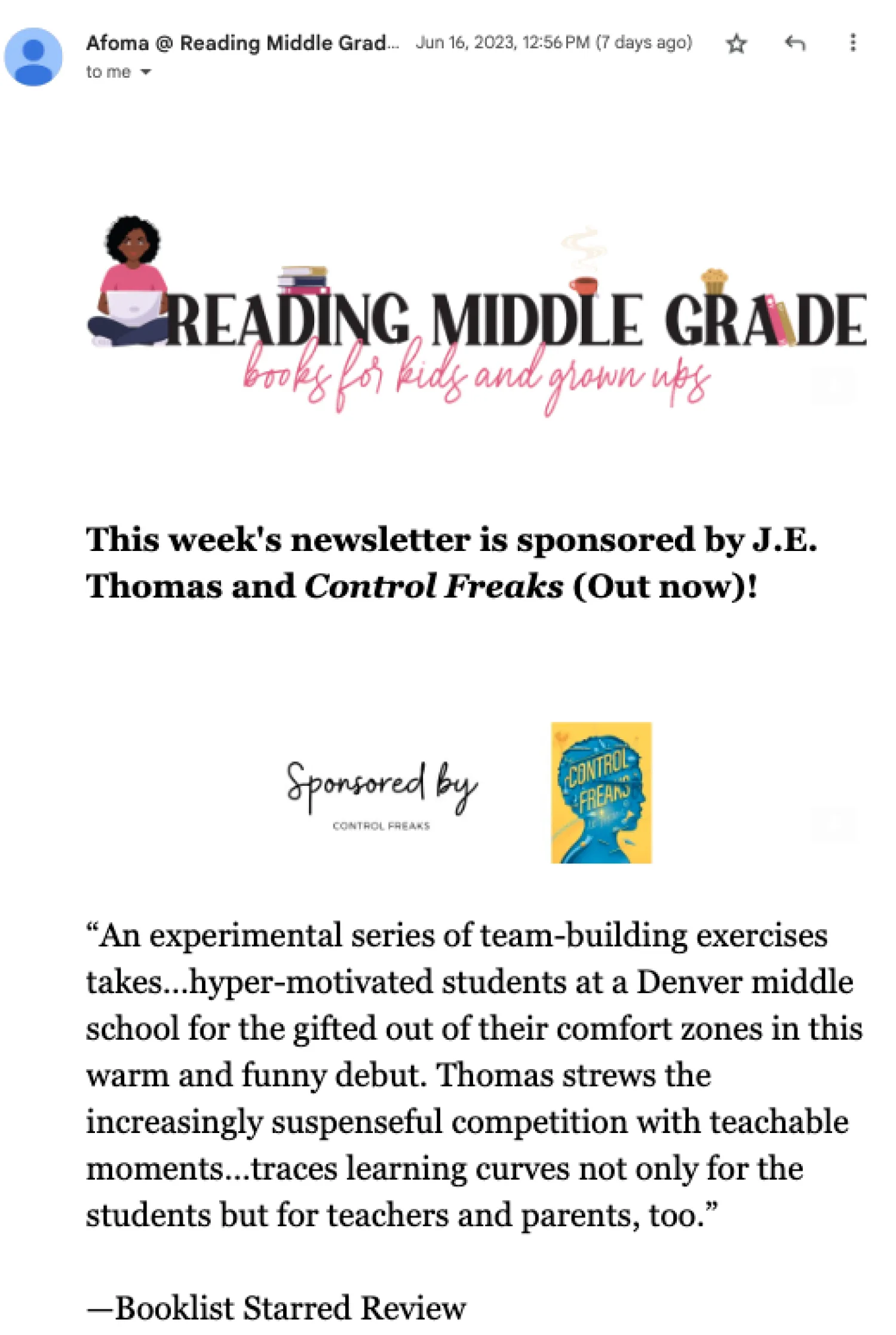
Mobile view
Notice that even on mobile:
- There’s enough white space to make the email readable
- The images render well and can be seen clearly
Again, writing shorter paragraphs (1-3 lines on desktop when you create your email) makes a huge difference.
Best practices for sending your newsletter
Sending the newsletter may seem like the easiest part, but there are a few important tips to keep in mind.
8. Use email segmentation to send personalized content
Email segmentation groups subscribers into smaller segments based on specific attributes.
For example, if you’re a DIY blogger, your subscribers might be other crafters interested in your projects.
From there, you can break down (or segment) your list further, such as:
- Knitters
- Child-friendly crafters
- Home decor DIYers
After segmenting your email list, you can craft and send personalized content to each segment. This ensures that everyone in your audience gets exactly what they need from your newsletter and helps keep your subscribers engaged.
At Kit, our tags and segments help you effortlessly segment your subscribers so you can increase conversions and sales!
Example: Erin Flynn of Design Bread
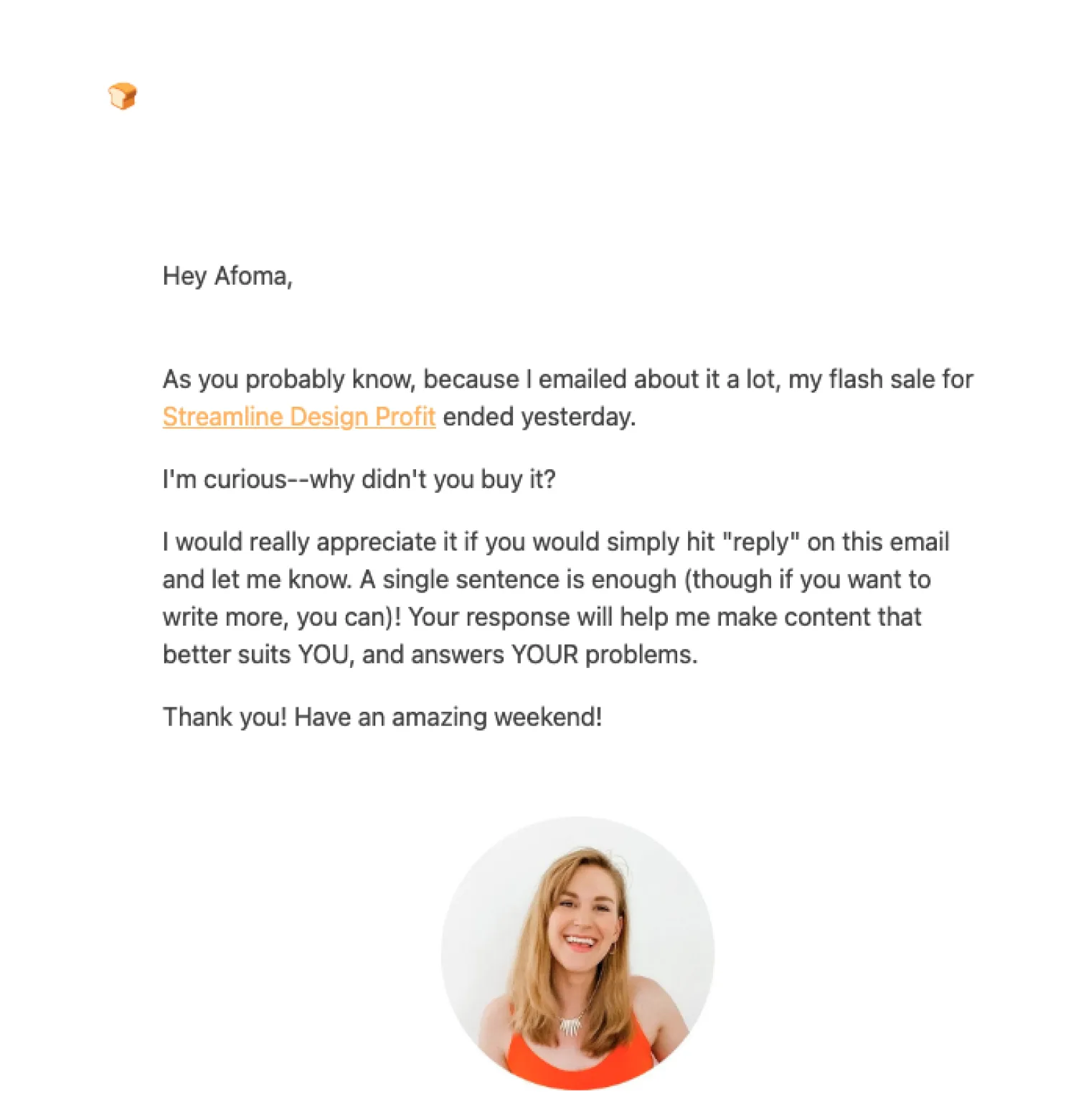
Erin Flynn of Design Bread sends targeted emails like the one above using segmentation. Notice that:
- She personalizes the email by using my first name
- The email mentions the fact that I did not purchase her course (which I didn’t)
- This personalized email has a call-to-action which will engage its recipients
This email caught my attention quickly because it was so obviously meant for me. That’s the power of segmentation.
9. Send exclusive and valuable content
Your subscribers’ inboxes are overflowing as it is. If you want to stand out (which I know you do), you’ll need to provide exclusive content personalized to each reader. Otherwise, there isn’t any incentive to stay on your email list.
There are many kinds of exclusive content you can send to engage your audience, including:
- Special offers
- Blog post recaps
- Loyalty emails
- Behind-the-scenes or exclusive looks into your business
Example: Kelsey at Paper and Oats
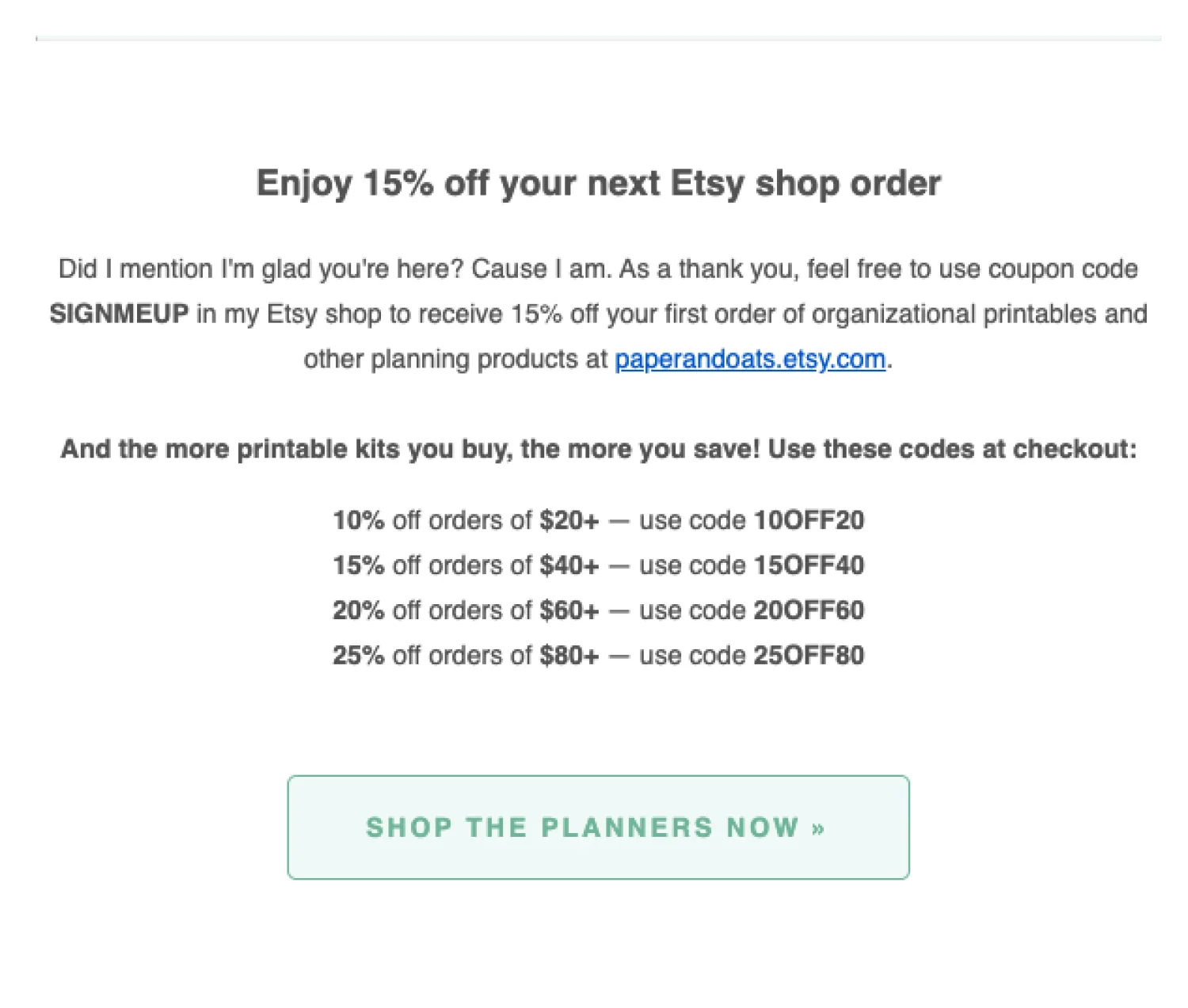
Designer Kelsey at Paper and Oats offers an Etsy discount code for her shop to welcome new subscribers. It works because:
- It’s a very warm way to welcome new subscribers
- She offers higher discounts for more purchases
- Exclusive content like this builds subscriber loyalty
10. Test different times to send (+ frequency)
Just as there’s the best time to post to Instagram and other social media platforms, there are good and bad times to send your emails.
According to our email marketing stats report, the most popular day to send an email for creators is Tuesday. Saturday is the least popular send day. Depending on your audience, you could decide to go with the more popular option (it’s popular for a reason!) or choose Saturday when inboxes are less crowded.
You can also dive into your website analytics to understand when your audience is online. These are likely the best times to send your newsletter.
Take the screenshot below, for example:

Look at your website analytics to see when your audience is online.
From this screenshot, my website readers are most online at midday and later in the evenings.
Monitoring this for several days and comparing any changes between weekdays and weekends would help you understand when to send your emails.
Example: James Clear
Author James Clear has a popular newsletter that goes out on the same day every week.
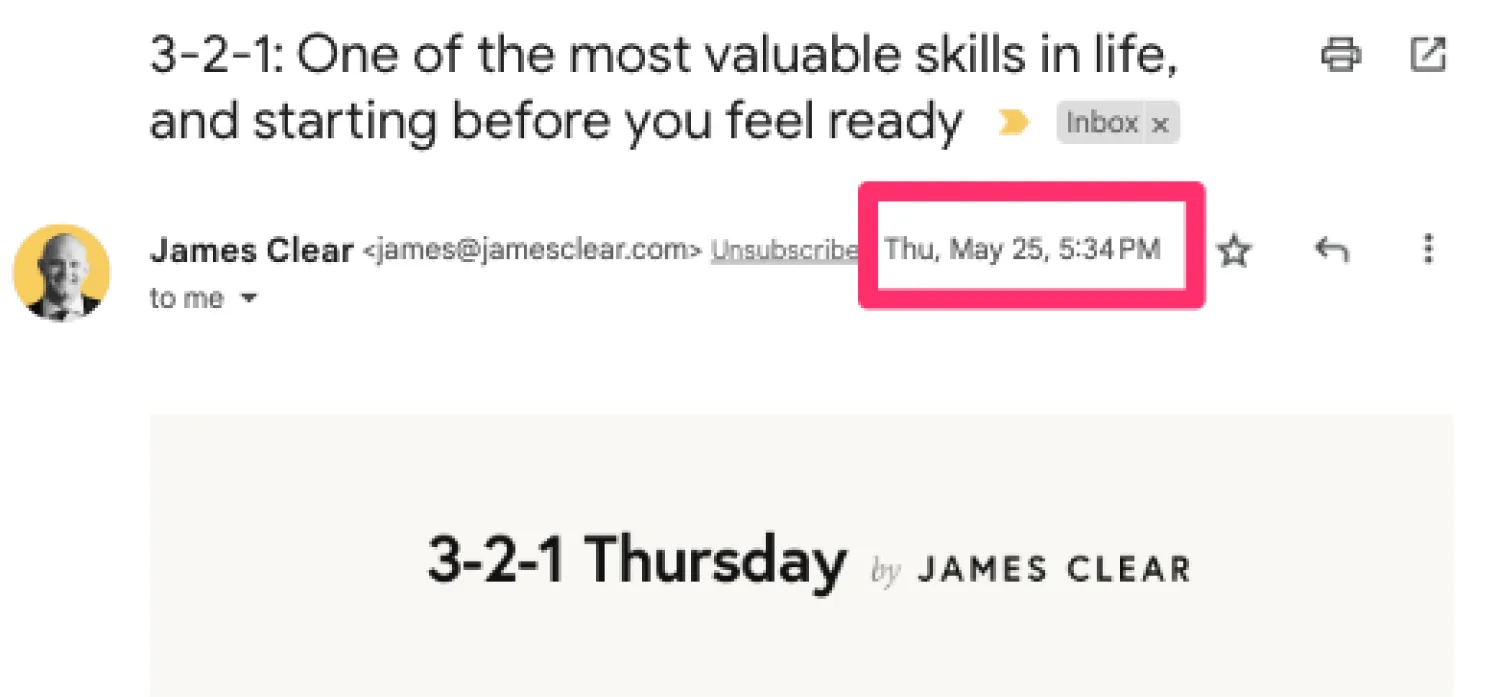
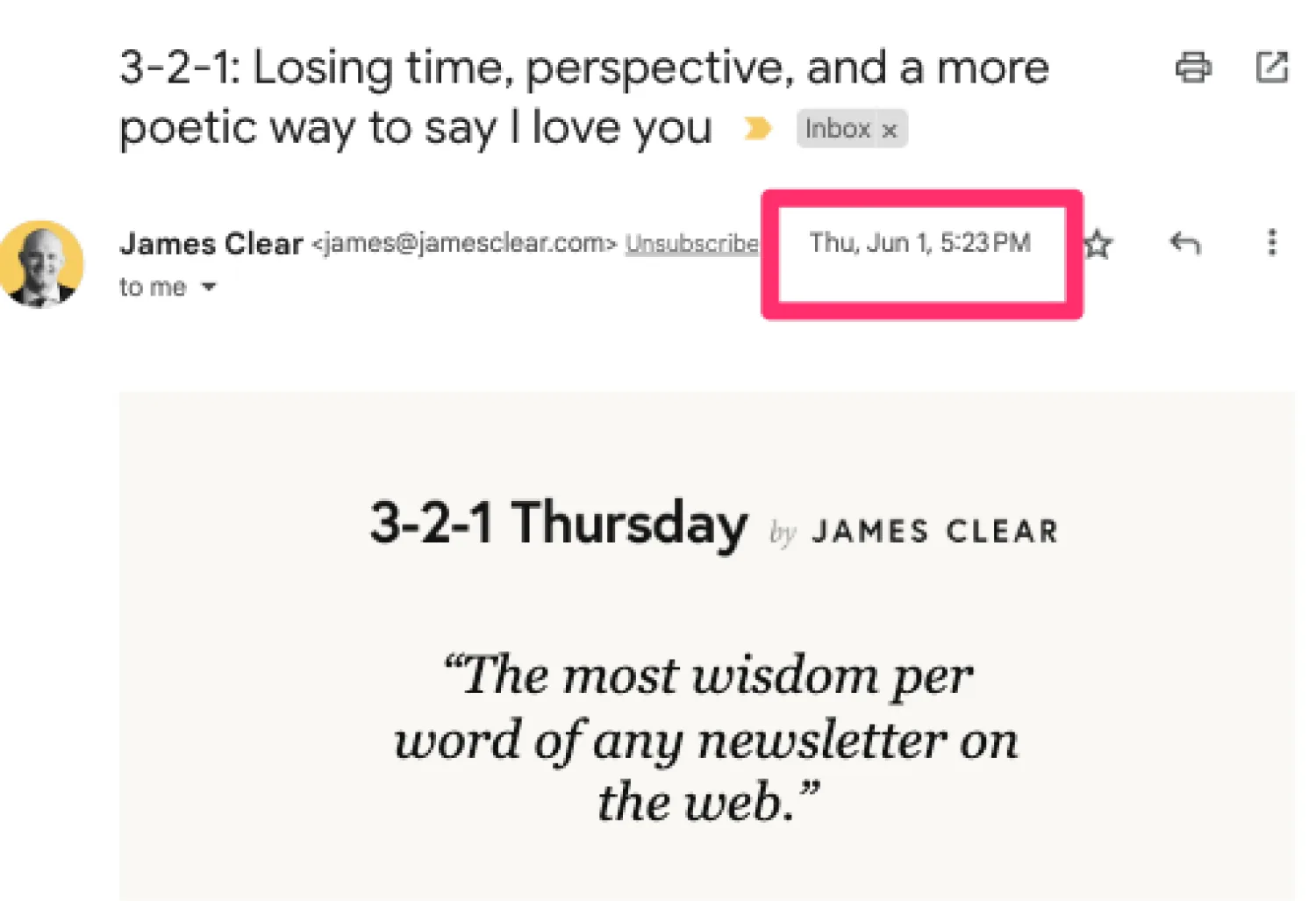
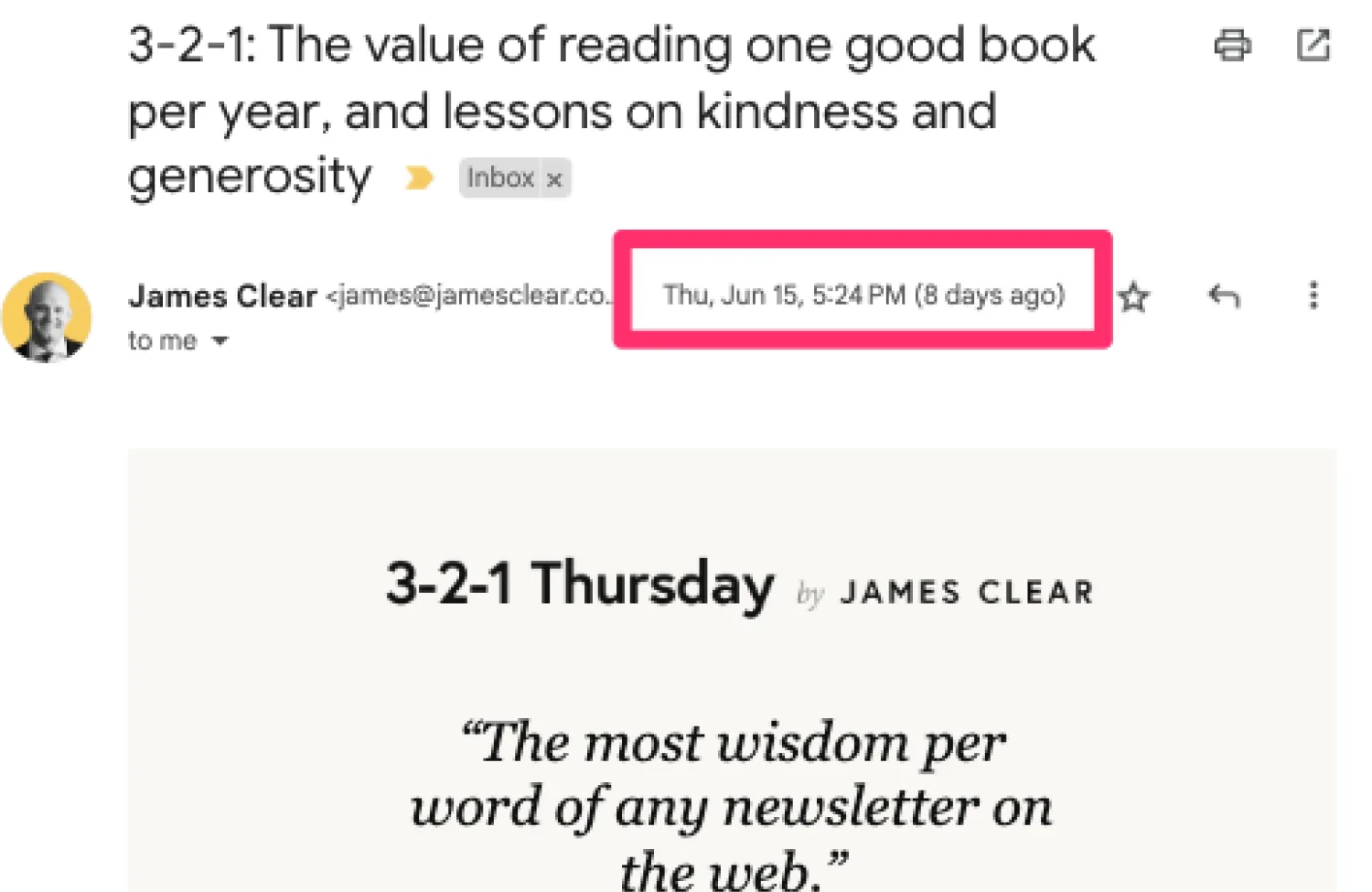
As one of his subscribers, I can tell you that:
- He rarely misses a Thursday
- Each newsletter goes out between 5-6 PM my time
- I’ve come to expect his newsletters, which means I always open them
More tips to help you improve your newsletters
Your newsletter is ready to go! But there are two extra tips you can try to get the best out of each email.
11. Always test your newsletter before sending it
Always do a quick test before sending. That way, you’ll ensure it’s readable, the design translates well, and you’ll see how it will look on different devices.
The easiest way to do it is to preview the newsletter in Kit by sending it to your email address. You can then open the email on your desktop and mobile.
Here are two other ways to do it:
1. With Chrome Dev Tools: You’ll need to be using the Chrome browser for this. On Windows, use the shortcut “Shift+Ctrl+i” or “Command+Option+i” on a Mac. In the screen that follows, click on “Toggle device toolbar.” From the dropdown menu at the top of the screen, you can choose from different devices to view your content.
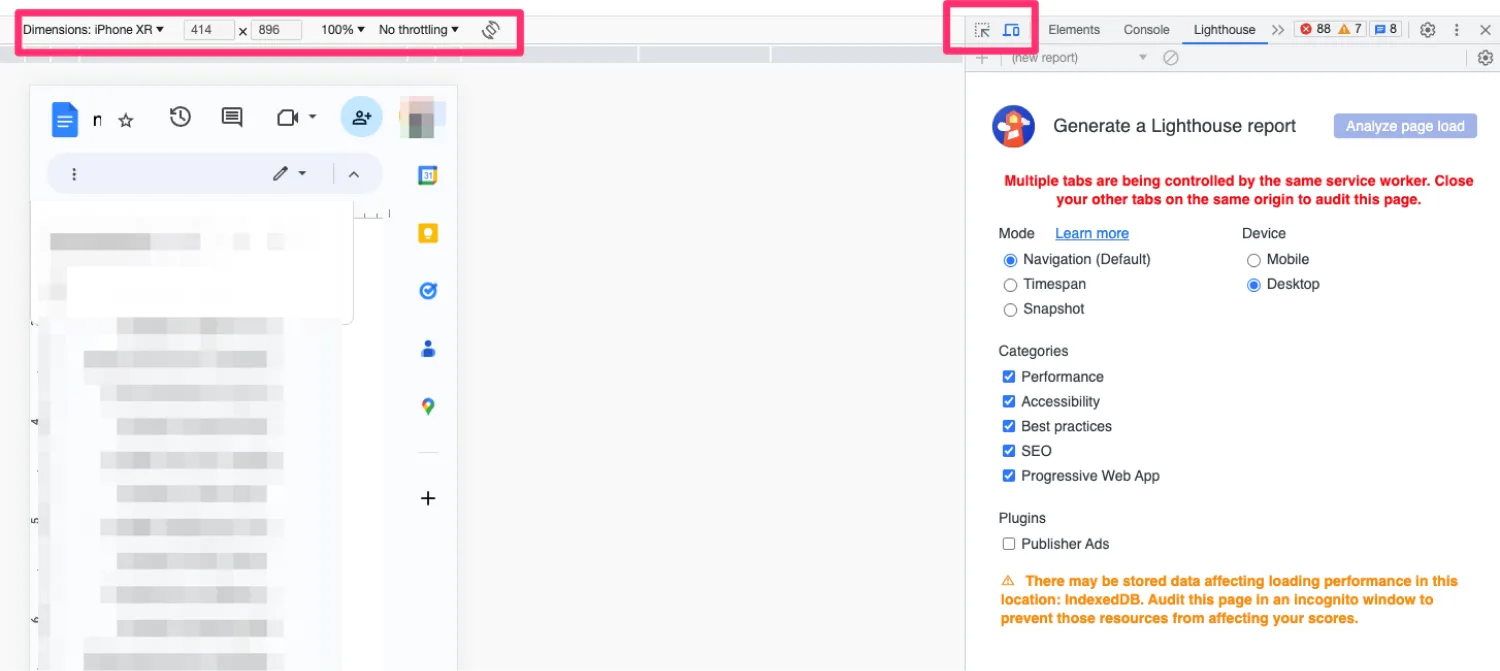
Test your newsletter using Chrome Dev Tools
2. With your browser window: Resizing your browser is another quick way to see how your newsletter design will appear on smaller screens! Although you can’t specify which device you’d like to emulate, as you can with Chrome DevTools, you’ll still see if your design is suitable for smaller screens.
12. Keep an eye on your email metrics
Even though email marketing metrics aren’t as thrilling as writing emails and hitting send, your analytics contain powerful information. When you learn to use them properly, you can supercharge your email marketing strategy.
A few important email marketing metrics to pay attention to are:
- Open rate
- Click rate
- Deliverability rate
- Conversion rate
- Unsubscribe rate
For example, a high unsubscribe rate might indicate a disconnect between the content you send out versus your initial lead magnet. On the other hand, a high click rate could mean your audience loves your content.
Pay attention to changes in these metrics, especially when you experiment with new designs, formats, or schedules for your email newsletters. They’ll tell you whether or not your subscribers like the new changes.
Create a newsletter your audience will love
Sending out your email newsletter doesn’t need to be overwhelming or scary.
The above email newsletter best practices will help you increase conversions and build a strong connection with your readers. You will be confident your emails remain spam-free and provide valuable content!
Kit’s suite of tools will equip you with everything you need to attract quality subscribers, design visually appealing newsletters and knock your email marketing out of the park.


